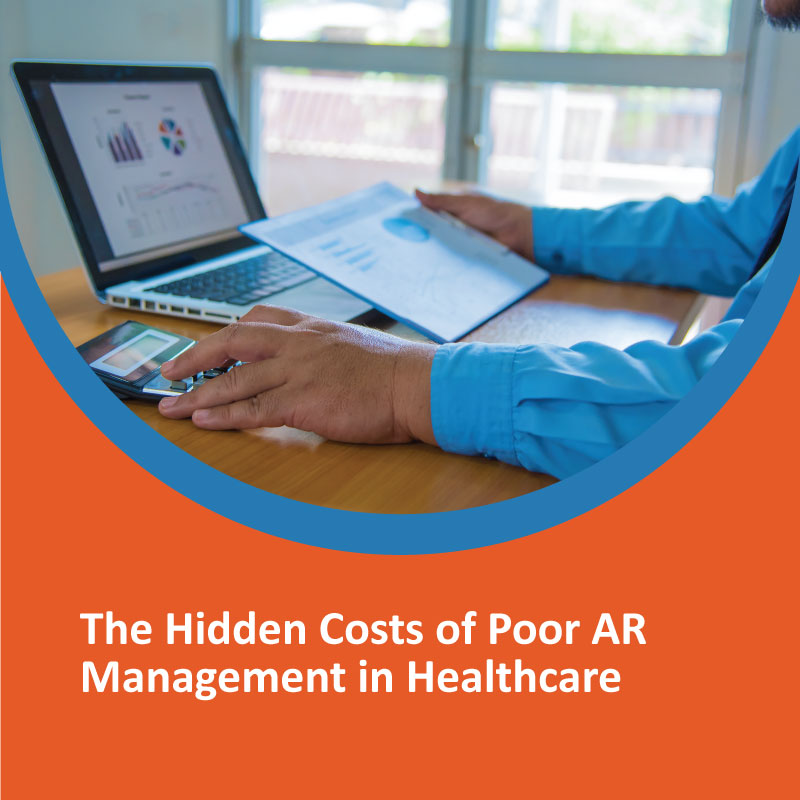Financial management may not be the first thing that comes to mind when you think of healthcare. Yet, accounts receivable (AR) management is the backbone of any healthcare practice’s financial health. AR management involves tracking, managing, and collecting payments from patients and insurance providers. When it’s poorly managed, the hidden costs can pile up, affecting everything from cash flow to patient satisfaction.
What Is Poor AR Management?
Signs of Inefficient AR Management
Poor AR management is often marked by high outstanding balances, delayed payments, and frequent billing errors. Practices may struggle to collect timely payments, leading to longer revenue cycles and financial stress.
Common Mistakes in AR Management
Mistakes such as failing to verify patient insurance details, inconsistent follow-ups, and outdated billing systems can lead to inefficiencies. These mistakes hurt revenue and damage the trust between patients and healthcare providers.
The Financial Impact of Poor AR Management
- Revenue Cycle Inefficiencies: Poor AR practices can throw revenue cycles off track. When billing and collections are delayed, healthcare providers face cash flow gaps that hinder daily operations.
- Causes of Healthcare Revenue Loss: Uncollected patient balances and claim denials are among the leading causes of revenue loss in healthcare. Poor AR management often overlooks these issues, letting them snowball into significant financial setbacks.
- Impact on Cash Flow and Operations: Inconsistent cash flow can lead to delayed payments to vendors, difficulties in maintaining staff salaries, and even compromised patient care.
Hidden Costs in AR Management
Administrative Costs and Inefficiencies
Managing AR manually requires time, effort, and money. These administrative costs can be significantly higher in the absence of streamlined processes.
Patient Billing Errors
Patient billing errors, such as incorrect charges or failure to send bills on time, result in revenue loss and patient dissatisfaction.
Loss of Patient Trust and Satisfaction
When billing processes are unclear or riddled with errors, patients are more likely to lose trust in the healthcare provider, which can affect long-term relationships.
The Ripple Effect on Healthcare Practices
Delayed Reimbursements
Poor AR management often leads to delays in insurance reimbursements, creating a backlog that affects overall cash flow.
Resource Misallocation
Time and money spent on correcting billing errors or chasing payments could have been better allocated to improving patient care.
Impact on Staff Productivity
Inefficient AR systems can overwhelm staff, leading to burnout and reduced productivity.
Healthcare Financial Challenges Linked to AR Inefficiencies
With rising operational costs and an increasing number of insurance claim denials, poor AR management only adds to the financial challenges faced by healthcare practices.
The Role of Technology in Reducing AR Costs
Automation in AR Management
Modern tools automate repetitive tasks like billing and payment tracking, reducing errors and saving time.
Benefits of Data Analytics
Using data analytics, healthcare providers can identify problem areas in their AR processes and implement targeted improvements.
Best Practices for Improving AR Management
Training Staff on AR Processes
Educating staff about AR best practices ensures they are equipped to handle the challenges effectively.
Streamlining Patient Billing Systems
Investing in user-friendly billing systems simplifies the process for both staff and patients, improving payment collection rates.
Regular Audits of AR Processes
Conducting periodic audits can help identify inefficiencies and provide actionable insights to optimize AR management.
Key Strategies for Avoiding Revenue Loss
Setting Clear Payment Policies
Transparent payment policies communicated upfront to patients can significantly reduce disputes and delays.
Enhancing Communication with Patients
Frequent reminders and clear billing statements improve payment compliance and patient trust.
Monitoring KPIs Regularly
Tracking key performance indicators (KPIs), such as the average collection period and claim denial rates, can help healthcare practices manage their finances.
Conclusion
Poor AR management is a silent financial drain on healthcare practices, with hidden costs ranging from administrative inefficiencies to patient dissatisfaction. By adopting best practices, leveraging technology, and addressing inefficiencies head-on, healthcare providers can secure their financial health and focus on delivering better care.
FAQs
Q1. What are the common challenges in AR management?
Common challenges include claim denials, patient billing errors, and a lack of automated processes.
Q2. How can poor AR management affect patient relationships?
Billing errors and delays can frustrate patients, leading to a loss of trust and satisfaction.
Q3. What tools can help improve AR management?
Automation tools, billing software, and data analytics platforms are highly effective for AR management.
Q4. Why is revenue cycle management important in healthcare?
Efficient revenue cycle management ensures consistent cash flow, enabling healthcare providers to focus on quality patient care.
Q5. What are the benefits of regular AR audits?
Audits help identify inefficiencies, prevent revenue loss, and improve overall financial performance.



